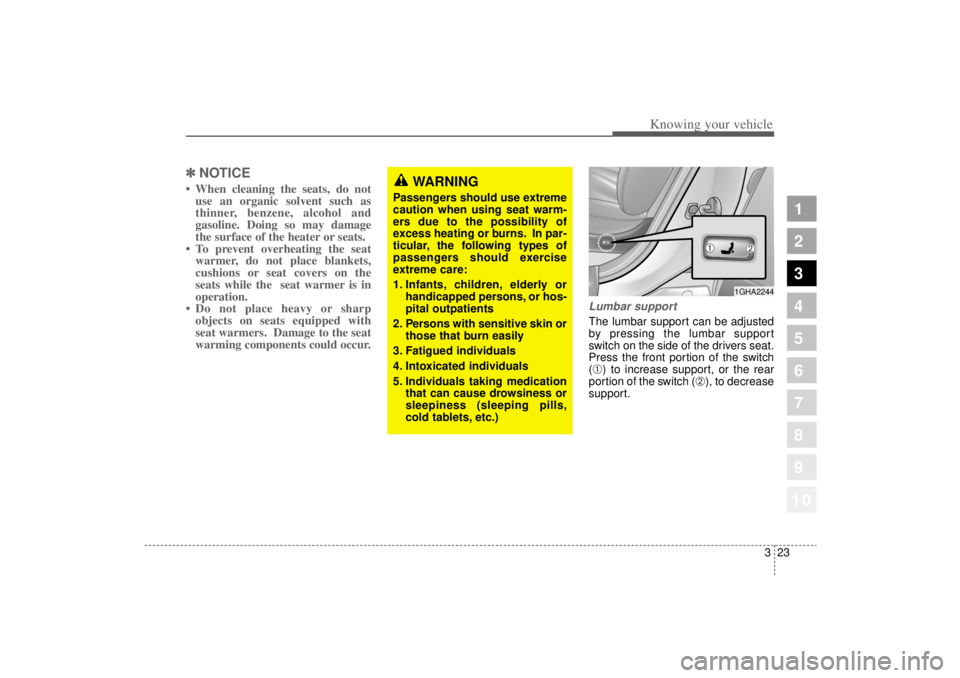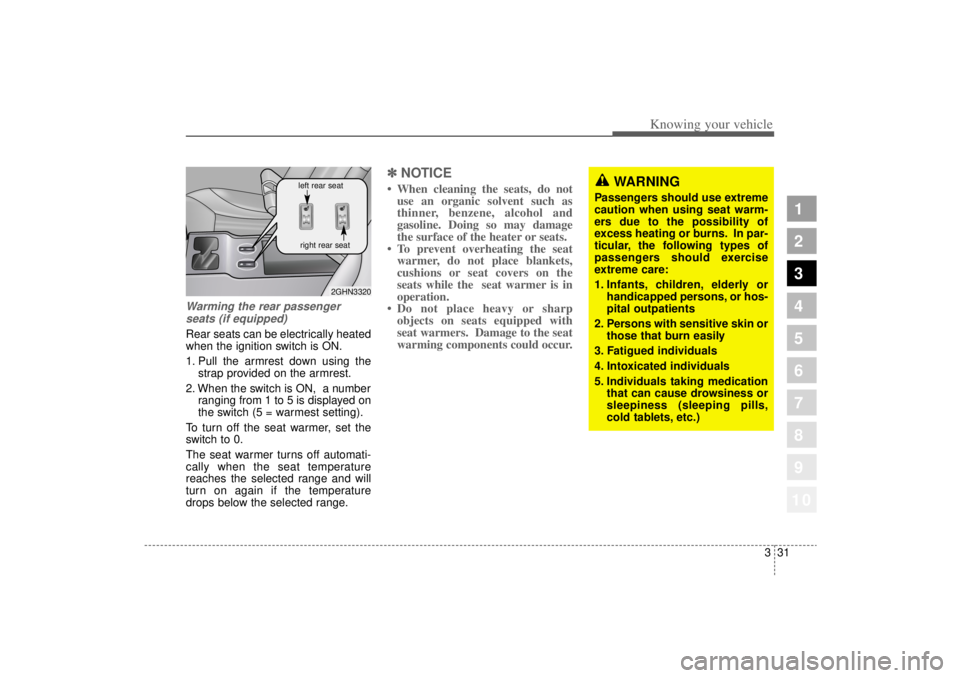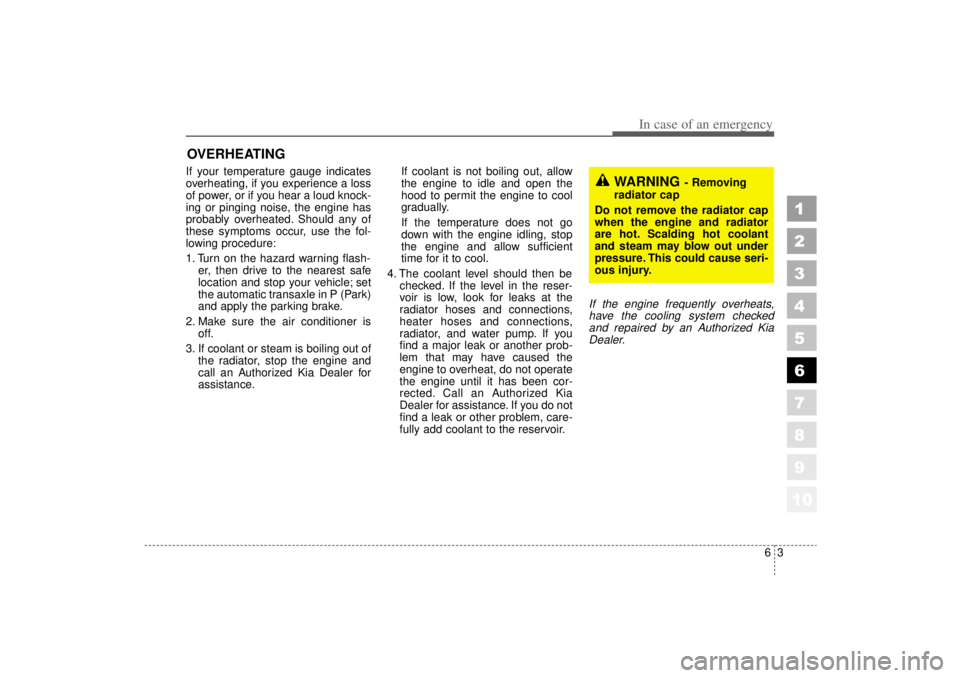Page 29 of 322
Knowing your vehicle18
3
1
2
3
4
5
6
7
8
910
Driver’s seat
➀
Seat adjustment, forward / back-
ward/height (see page 3- 20)
➁
Seatback recliner (see page 3- 22)
➂
Seat heater switch (see page 3- 22)
➃
Lumbar support (see page 3- 23)
➄
Driver position memory system
(see page 3- 24)
Headrest adjustment (headrest
can not be adjusted by a switch)(see page 3- 24)
Front passenger seat
\b
Seat adjustment, forward / back-
ward (see page 3- 25)
➆
Seatback recliner (see page 3- 26)
➇
Seat heater switch (see page 3- 27)
Headrest adjustment (headrest
can not be adjusted by a switch)(see page 3- 28)
Rear seat
\f
Seat heater switch (left) (see page 3- 31)
➉
Seat heater switch (right)(see page 3- 31)
Headrest adjustment (see page 3- 32)
SEAT
ESP
5GHN2025
Page 34 of 322

323
1
2
3
4
5
6
7
8
910
Knowing your vehicle
✽ ✽NOTICE• When cleaning the seats, do not
use an organic solvent such as
thinner, benzene, alcohol and
gasoline. Doing so may damage
the surface of the heater or seats.
• To prevent overheating the seat warmer, do not place blankets,
cushions or seat covers on the
seats while the seat warmer is in
operation.
• Do not place heavy or sharp objects on seats equipped with
seat warmers. Damage to the seat
warming components could occur.
Lumbar supportThe lumbar support can be adjusted
by pressing the lumbar support
switch on the side of the drivers seat.
Press the front portion of the switch
(➀) to increase support, or the rear
portion of the switch (
➁), to decrease
support.
WARNING
Passengers should use extreme
caution when using seat warm-
ers due to the possibility of
excess heating or burns. In par-
ticular, the following types of
passengers should exercise
extreme care:
1. Infants, children, elderly or handicapped persons, or hos-
pital outpatients
2. Persons with sensitive skin or those that burn easily
3. Fatigued individuals
4. Intoxicated individuals
5. Individuals taking medication that can cause drowsiness or
sleepiness (sleeping pills,
cold tablets, etc.)
1GHA2244
➀
➁
Page 38 of 322
327
1
2
3
4
5
6
7
8
910
Knowing your vehicle
Warming the front passengerseats (if equipped)The front seats can be electrically
heated individually when the ignition
switch is ON. When the switch is ON,
a number ranging from 1 to 5 is dis-
played on the switch (5 = warmest
setting).
To turn off the seat warmer, set the
switch to 0. The seat warmer turns off automati-
cally when the seat temperature
reaches the selected range and will
turn on again if the temperature
drops below the selected range.
✽ ✽
NOTICE• When cleaning the seats, do not
use an organic solvent such as
thinner, benzene, alcohol and
gasoline. Doing so may damage
the surface of the heater or seats.
• To prevent overheating the seat warmer, do not place blankets,
cushions or seat covers on the
seats while the seat warmer is in
operation.
• Do not place heavy or sharp objects on seats equipped with
seat warmers. Damage to the seat
warming components could occur.
1GHA2051A
Page 42 of 322

331
1
2
3
4
5
6
7
8
910
Knowing your vehicle
Warming the rear passengerseats (if equipped)Rear seats can be electrically heated
when the ignition switch is ON.
1. Pull the armrest down using the strap provided on the armrest.
2. When the switch is ON, a number ranging from 1 to 5 is displayed on
the switch (5 = warmest setting).
To turn off the seat warmer, set the
switch to 0.
The seat warmer turns off automati-
cally when the seat temperature
reaches the selected range and will
turn on again if the temperature
drops below the selected range.
✽ ✽ NOTICE• When cleaning the seats, do not
use an organic solvent such as
thinner, benzene, alcohol and
gasoline. Doing so may damage
the surface of the heater or seats.
• To prevent overheating the seat warmer, do not place blankets,
cushions or seat covers on the
seats while the seat warmer is in
operation.
• Do not place heavy or sharp objects on seats equipped with
seat warmers. Damage to the seat
warming components could occur.
WARNING
Passengers should use extreme
caution when using seat warm-
ers due to the possibility of
excess heating or burns. In par-
ticular, the following types of
passengers should exercise
extreme care:
1. Infants, children, elderly or
handicapped persons, or hos-
pital outpatients
2. Persons with sensitive skin or those that burn easily
3. Fatigued individuals
4. Intoxicated individuals
5. Individuals taking medication that can cause drowsiness or
sleepiness (sleeping pills,
cold tablets, etc.)
2GHN3320
left rear seat
right rear seat
Page 105 of 322
Knowing your vehicle94
3
1
2
3
4
5
6
7
8
910
CAUTION
Do not place objects in the rear
seat or cargo area which wouldinterfere with your vision outthe rear window.
Folding the outside rearview
mirrorManual type
To fold outside rearview mirror, grasp
the housing of mirror and then fold it
toward the rear of the vehicle.
Outside rearview mirror heater (if equipped) The outside rearview mirror heater is
actuated in connection with the rear
window defroster. To heat the outside
rearview mirror glass, push the but-
ton for the rear window defroster.
The outside rearview mirror glass will
be heated for defrosting or defogging
and will give you improved rear
vision in inclement weather condi-
tions. Push the button again to turn
the heater off. The outside rearview
mirror heater automatically turns off
after 20 minutes.
Day/night rearview mirror Adjust the rearview mirror to center
on the view through the rear window.
Make this adjustment before you
start driving.
E1V2B03032
Page 117 of 322

Knowing your vehicle106
3
1
2
3
4
5
6
7
8
910
✽ ✽
NOTICE• Use when the engine is running
and remove a plug from the power
outlet after using the electric
appliance. Using when the engine
stops or remaining the electric
appliance with plugged in for
many hours may cause the battery
to be discharged.
• Only use the electric appliances which are less than 12V and 10A
in electric capacity.
• Adjust the air-conditioner or heater to the lowest operation level
when you have to use the power
socket while using air-conditioner
or heater.
• Close the cover when not in use.
• Some electronic devices can cause electronic interference and when
plugged into a vehicle's power out-
let. These devices may cause
excessive audio static and mal-
functions in other electronic sys-
tems or devices used in your vehi-
cle.
ClockAnalog (if equipped)Whenever the battery terminals, A/V
CLOCK fuse, or Power Connect are
disconnected, you must reset the
time.
When the ignition switch is in the
ACC or ON position, the clock but-
tons operate as follows:
➀
(+) : time increases one minute
each time the button is
pressed. It increases continu-
ously if pressed longer than 3
seconds.
➁
(-) : time decreases one minuteeach time the button is
pressed. It decreases continu-
ously if pressed longer than 3
seconds.
5GHA2232
➀
➁
Page 192 of 322
Driving your vehicle70
4
1
2
3
4
5
6
7
8
910
For maximum defrosting, set the
temperature control button to the
hot position and the fan speed con-
trol button to the highest speed.
If warm air to the floor is desired while defrosting or defogging, set
the mode selection button to the
floor- defrost position.
Before driving, clear all snow and ice from the windshield, rear win-
dow, outside rear view mirrors, and
all side windows.
Clear all snow and ice from the hood and air inlet in the cowl grill to
improve heater and defroster effi-
ciency and to reduce the probabili-
ty of fogging up inside of the wind-
shield.
Page 223 of 322

63
In case of an emergency
OVERHEATING If your temperature gauge indicates
overheating, if you experience a loss
of power, or if you hear a loud knock-
ing or pinging noise, the engine has
probably overheated. Should any of
these symptoms occur, use the fol-
lowing procedure:
1. Turn on the hazard warning flash-er, then drive to the nearest safe
location and stop your vehicle; set
the automatic transaxle in P (Park)
and apply the parking brake.
2. Make sure the air conditioner is off.
3. If coolant or steam is boiling out of the radiator, stop the engine and
call an Authorized Kia Dealer for
assistance. If coolant is not boiling out, allow
the engine to idle and open the
hood to permit the engine to cool
gradually.
If the temperature does not go
down with the engine idling, stop
the engine and allow sufficient
time for it to cool.
4. The coolant level should then be checked. If the level in the reser-
voir is low, look for leaks at the
radiator hoses and connections,
heater hoses and connections,
radiator, and water pump. If you
find a major leak or another prob-
lem that may have caused the
engine to overheat, do not operate
the engine until it has been cor-
rected. Call an Authorized Kia
Dealer for assistance. If you do not
find a leak or other problem, care-
fully add coolant to the reservoir.
If the engine frequently overheats,have the cooling system checkedand repaired by an Authorized KiaDealer.
1
2
3
4
5
6
7
8
910
WARNING
- Removing
radiator cap
Do not remove the radiator cap
when the engine and radiator
are hot. Scalding hot coolant
and steam may blow out under
pressure. This could cause seri-
ous injury.